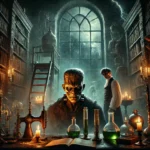Hamlet, written by William Shakespeare in approximately 1600, is one of the most famous and profound tragedies in English literature. Set in the kingdom of Denmark, the play follows the young Prince Hamlet as he grapples with grief, revenge, and madness after the murder of his father, King Hamlet, by his uncle Claudius. Claudius has seized the throne and married Hamlet’s mother, Queen Gertrude, setting the stage for a complex narrative of deceit, betrayal, and existential pondering. The play’s exploration of moral corruption, the complexities of human nature, and the consequences of revenge has made it a timeless masterpiece.
Plot Summary
On a cold night, a ghostly figure haunts the battlements of Elsinore, the royal castle of Denmark. The sentries are startled when they recognize the apparition as the recently deceased King Hamlet. They decide to inform Prince Hamlet, the son of the dead king, hoping he will know how to interpret this troubling vision. Hamlet, deeply grieving his father’s sudden death and disturbed by his mother Gertrude’s swift marriage to his uncle Claudius, is summoned to the encounter with the ghost.
The new King Claudius holds court, addressing the nation about the recent events. He speaks of the sorrow of his brother’s death but also defends his marriage to Queen Gertrude as a necessary step for the kingdom’s stability. He diplomatically addresses the potential threat from young Fortinbras of Norway, who seeks to reclaim lands lost by his father in battle. As the court disperses, Hamlet remains in turmoil. He is disgusted by his mother’s hasty remarriage, which he views as a betrayal, and he suspects Claudius of foul play.
Later that night, Hamlet encounters the ghost of his father, who reveals the terrible truth: King Hamlet was murdered by Claudius, who poured poison into his ear while he slept. The ghost demands that Hamlet avenge his death but warns him not to harm Gertrude, leaving her fate to the heavens. Overwhelmed with anger and grief, Hamlet swears to take revenge but is troubled by the weight of the task. His philosophical nature leads him to hesitate, as he ponders the morality of taking another man’s life, even one as corrupt as Claudius.
Hamlet adopts a guise of madness to mask his true intentions, hoping to bide his time and gather more evidence of Claudius’s guilt. His behavior alarms those around him, particularly his love, Ophelia, the daughter of the king’s advisor, Polonius. Polonius, convinced that Hamlet’s madness stems from unrequited love for Ophelia, informs Claudius and Gertrude. Claudius, however, remains unconvinced and sends Rosencrantz and Guildenstern, two of Hamlet’s former friends, to spy on him and discover the true source of his distress.
Meanwhile, Hamlet grows increasingly bitter. He delivers his famous soliloquy, contemplating the nature of life and death, and whether it is nobler to endure suffering or to end it all. His inner turmoil intensifies as he stages a play called The Mousetrap, which mirrors the circumstances of King Hamlet’s murder. Hamlet plans to watch Claudius’s reaction closely, hoping it will confirm his guilt.
As the play unfolds, Claudius becomes visibly agitated and abruptly leaves the room, confirming Hamlet’s suspicions. Energized by the success of his scheme, Hamlet confronts his mother, Gertrude, in her chambers. In the heat of the confrontation, he hears a noise behind a curtain and, thinking it might be Claudius spying on him, stabs the unseen figure. The body is revealed to be Polonius, Ophelia’s father, whom Hamlet has killed by mistake.
This murder sets off a tragic chain of events. Ophelia, devastated by her father’s death and Hamlet’s rejection of her, descends into madness. Her grief overtakes her, and soon she drowns in a nearby river under mysterious circumstances. Her brother Laertes, returning from France, is consumed with rage upon learning of his father’s death and his sister’s tragic end. With Claudius manipulating him, Laertes vows to take revenge on Hamlet.
Claudius, sensing an opportunity to rid himself of Hamlet, proposes a duel between Hamlet and Laertes. The match, however, is a deadly trap. Laertes’ sword is tipped with poison, and Claudius prepares a cup of poisoned wine as a backup plan. The scene is set for the final act of betrayal and bloodshed.
The duel begins, and though Hamlet initially refuses to drink from the poisoned cup, Gertrude unknowingly drinks it and collapses, dying before their eyes. In the chaos, Laertes strikes Hamlet with the poisoned sword, but in a struggle, their weapons are switched, and Laertes is wounded by his own blade. As both men realize they are dying, Laertes confesses the plot and forgives Hamlet. The two exchange words of reconciliation as Laertes succumbs to the poison.
Hamlet, now mortally wounded, turns his attention to Claudius. In his final moments, Hamlet forces Claudius to drink from the poisoned cup, at last avenging his father’s murder. With his vengeance complete, Hamlet collapses, and his dying request is for his friend Horatio to tell his story and ensure his legacy.
As Hamlet dies, Fortinbras, the Norwegian prince, arrives with his army, having conquered Denmark while its leaders were entangled in their own destruction. Fortinbras surveys the scene of carnage and, with a sense of solemnity, orders that Hamlet’s body be carried away with the honors befitting a fallen hero. The kingdom of Denmark lies in ruins, its royal family destroyed, as the cycle of revenge and corruption comes to its tragic conclusion.
Main Characters
Hamlet – The protagonist and Prince of Denmark, Hamlet is a deeply reflective and complex character. He is driven by grief and the desire for revenge against his uncle Claudius, who has murdered his father. Throughout the play, Hamlet struggles with indecision, the morality of revenge, and his own sanity. His soliloquies, especially “To be or not to be,” reveal his philosophical contemplations on life, death, and existence.
King Claudius – The antagonist of the play, Claudius is Hamlet’s uncle and the new king of Denmark. He is a cunning and ambitious ruler who has murdered his brother, King Hamlet, to seize the throne. Claudius’s political maneuvering and guilt over his actions form a central tension in the play, especially as Hamlet seeks to expose him.
Gertrude – Hamlet’s mother and the Queen of Denmark, Gertrude quickly marries Claudius after her first husband’s death. Hamlet is troubled by her hasty remarriage, seeing it as a betrayal. Throughout the play, Gertrude’s actions are often interpreted as those of a passive figure, caught between her son and her new husband, though her motivations remain ambiguous.
Ophelia – A young noblewoman and Hamlet’s love interest, Ophelia is often seen as a tragic figure who becomes a victim of the power struggles between the men in her life. Her descent into madness and eventual death by drowning are emblematic of the play’s exploration of innocence destroyed by corruption.
Polonius – The father of Ophelia and Laertes, and the chief advisor to King Claudius. Polonius is a pompous and meddling figure, whose death at the hands of Hamlet sparks further tragedy. His scheming and interference in Hamlet’s life help set off a chain of tragic events.
Laertes – Ophelia’s brother, Laertes is a foil to Hamlet. He is passionate and quick to action, particularly in seeking revenge for his father Polonius’s death. Unlike Hamlet, who contemplates his actions deeply, Laertes leaps into revenge with little hesitation, providing a contrast to Hamlet’s indecision.
The Ghost – The specter of King Hamlet, the former king of Denmark and Hamlet’s father. The Ghost reveals the truth about his murder to Hamlet, urging him to avenge his death, thus setting the main plot of the play into motion.
Theme
Revenge and Justice – Central to the play is Hamlet’s quest to avenge his father’s murder. However, the play complicates the traditional revenge tragedy by questioning the morality of vengeance and the consequences it brings. Hamlet’s delay in taking action reflects the complexity of justice, as he struggles with the ethical implications of killing Claudius.
Madness – Madness, both real and feigned, is a key motif in Hamlet. Hamlet pretends to be mad as part of his plan to investigate his father’s murder, but the line between pretense and reality blurs. Ophelia’s genuine descent into madness contrasts with Hamlet’s calculated behavior, highlighting themes of mental instability and the destructive effects of grief and trauma.
Death and the Afterlife – The play is steeped in meditations on death, from Hamlet’s obsession with mortality in his soliloquies to the Ghost’s revelations about purgatory. The graveyard scene, where Hamlet contemplates the skull of Yorick, is a powerful reflection on the inevitability of death and the futility of human endeavor.
Corruption and Decay – The imagery of physical and moral decay runs throughout the play, symbolized by the “rotten” state of Denmark under Claudius’s rule. From the murder of King Hamlet to the disintegration of relationships, Hamlet explores how corruption infects both the individual and the state, leading to inevitable ruin.
Action vs. Inaction – Hamlet’s philosophical dilemma revolves around his inability to act decisively. His hesitation and intellectualization of action are in stark contrast to characters like Laertes, who is quick to seek revenge. This theme underscores the broader question of how one should respond to wrongdoing and the paralysis that can arise from overthinking.
Writing Style and Tone
Shakespeare’s writing in Hamlet is marked by its rich use of soliloquies, philosophical musings, and intricate wordplay. Hamlet’s soliloquies are particularly famous, offering insight into his tortured mind and allowing the audience to delve into his thoughts on existential questions, such as life, death, and the nature of reality. Shakespeare employs iambic pentameter and blank verse to elevate the language, while prose is often used for moments of comic relief or madness.
The tone of Hamlet is somber, introspective, and often filled with a sense of foreboding. The play is suffused with a melancholic atmosphere, as Hamlet grapples with the darkness of human nature, the inevitability of death, and the moral complexities of revenge. Shakespeare also weaves moments of irony, wit, and wordplay into the dialogue, especially in Hamlet’s interactions with other characters, which serve to underline his intelligence and the play’s thematic depth.
We hope this summary has sparked your interest and would appreciate you following Celsius 233 on social media:
There’s a treasure trove of other fascinating book summaries waiting for you. Check out our collection of stories that inspire, thrill, and provoke thought, just like this one by checking out the Book Shelf or the Library
Remember, while our summaries capture the essence, they can never replace the full experience of reading the book. If this summary intrigued you, consider diving into the complete story – buy the book and immerse yourself in the author’s original work.
If you want to request a book summary, click here.
When Saurabh is not working/watching football/reading books/traveling, you can reach him via Twitter/X, LinkedIn, or Threads
Restart reading!








